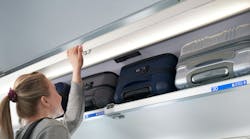Reliability and uptime are crucial to operating a successful baggage handling system (BHS). Building upon the solid performance of its predecessor, the Sinamics G115D distributed drive system from Siemens operates in systems around the world. “With its wide operating temperature range of -22 to 131 degrees F, and its rugged housing and connector options (rated up to UL Type 4X/IP66), the G115D is designed to withstand the environments where a BHS needs to operate,” said Ivan Spronk, Siemens Product Marketing Manager.
A “distributed drive” refers to the drives being mounted very close to the motors for a BHS instead of being mounted in a large, centrally located control cabinet. The system includes the drive, motor and gearbox.
Distributed drives eliminate the space and cost of having a large control cabinet filled with drives. They also eliminate the time and expense of installing long runs of motor power cables and control wiring from the control cabinet to all the motors located along a BHS.
“The majority of motors in a BHS are small motors in the ½ hp to 10 hp range so the drive electronics can be packaged in a compact form factor and can be easily mounted,” Spronk said.
Distributed drive systems can simplify the installation of a BHS. In fact, he said installers have reduced on-site installation times by 80% by using the SINAMICS G115D distributed drive.
The SINAMICS G115D was introduced in early 2021. “This second generation of distributed drives from Siemens builds upon experience gained in this application and incorporates features for efficient and reliable operation for conveyors, sortation systems and tray-based cargo conveyor lines that make a BHS,” Spronk said.
In addition to providing reliability and efficiency, he said the SINAMICS G115D distributed drive allows airport operators to address the current challenges of safety and total cost of ownership (TCO) for BHS.
Operational safety is integrated into the G115D by providing Safe Torque Off (STO), which is certified to IEC 61508 SIL 2 and EN ISO 13849-1 PL Category 3 as a standard feature. This functionality can be activated via fail-safe digital inputs on the drive or via PROFINET or PROFIBUS with PROFIsafe. There is also an option for Safe-Limited Speed (SLS).
In addition, the G115D has been designed to meet the new UL drive standard that specifies compliance testing for personnel and facility protection. Drives that comply with UL61800-5-1 meet a stricter standard for electrical, thermal and energy dissipation in the event of a short circuit downstream from the drive.
According to Spronk, operators can reduce TOC with the SINAMICS G115D because it enables efficient use of up-front engineering time, reducing component selection, configuration, and start-up time. The G115D is a part of the Siemens TIA (Total Integrated Automation) engineering portal that provides quick selection, parameterization, network topology configuration and innovative simulation tools. The built-in web server can be accessed with the optional Wi-Fi Smart Access Module to speed commissioning and provide diagnostic information. The on-board LED cluster provides constant status of the device. Once in operation, energy cost-optimization is realized as the G115D supports the IE2/IE3 asynchronous motors and IE4 synchronous reluctance high efficiency motors.
The SINAMICS G115D distributed drive system is ready for the future to keep today’s installations running and optimized. Thanks to communications interfaces, Edge data collection and integration of the Analyze MyDrives (AMD) application into the Insights Hub cloud solution, operating conditions of the drive system can always be visible. Cloud-based analytics and low-code application development enable data collection and analysis from the field. With these capabilities, actual usage data can be analyzed, creating a closed feedback loop and KPIs for continuous process optimization and improvement. Digitalization helps to provide full transparency in each project phase of planning, commissioning and operations, and can advance airport operators’ journey to a more digital, fine-tuned enterprise.
Spronk concluded by saying, “There are a limited number of manufacturers that can offer a distributed drive. The Siemens portfolio stands out when compared to others that have a distributed drive, but who don’t have complimentary portfolios, those who don’t have a global footprint, or those who only have a limited power range. The G115D power range from 1/2 to 10 hp, with its wide operating temperature range of -22 to 131 degrees F, and its rugged housing and connector options rated up to UL Type 4X/IP66 offers more. These benefits, combined with digitization capabilities, differentiate the SINAMICS G115D offering.”
In addition to the G115D distributed drive, Siemens SINAMICS low-voltage drives portfolio includes the G120D distributed drive, which is intended for decline conveyors and vertical motion applications. Both drives are particularly suitable for interaction with SIMATIC PLC controllers such as the S7-1200. Considering the main components of the BHS system, Siemens can provide a complete system from optical and RFID readers, Edge data collection devices, motors, geared motors, drives, PLC controllers, HMIs, security appliances, and connection to the cloud with data processing in the cloud to provide a complete BHS control system.
Siemens offers a comprehensive portfolio of SINAMICS drives for BHS that blend larger power requirements, where needed, and servo drive performance, where needed, into the same TIA portal engineering tool, providing a single software environment for planning, commissioning, and operations.





